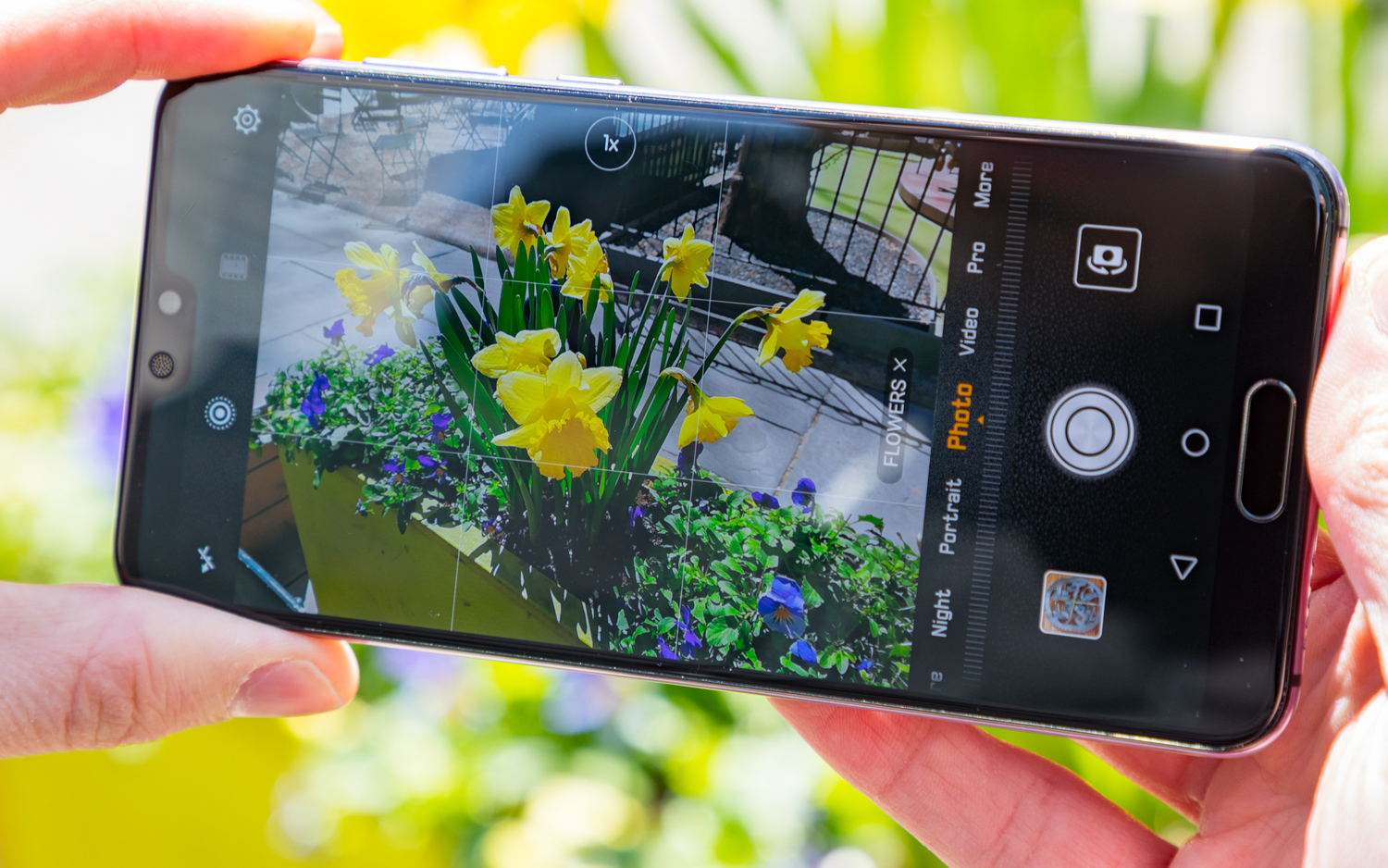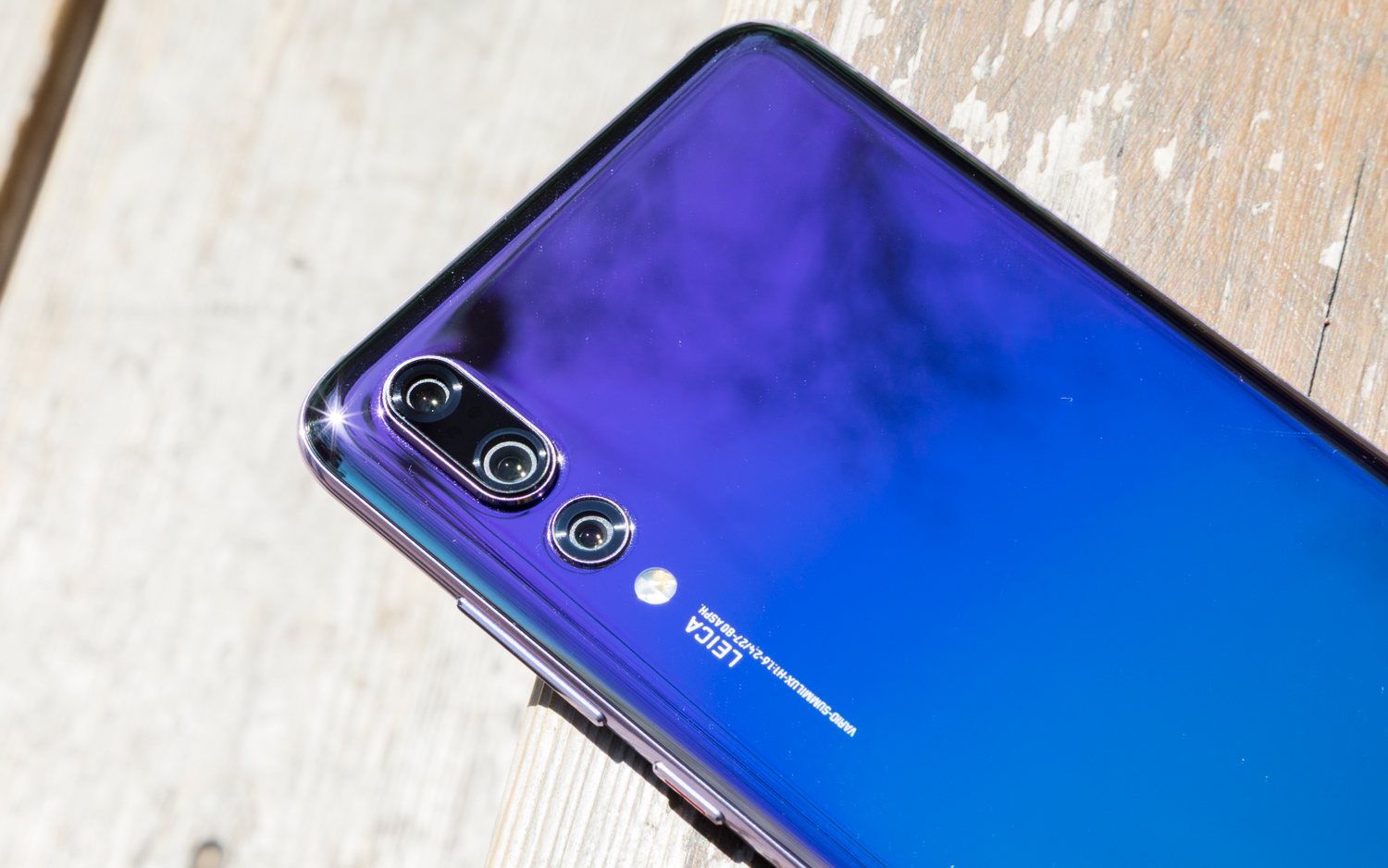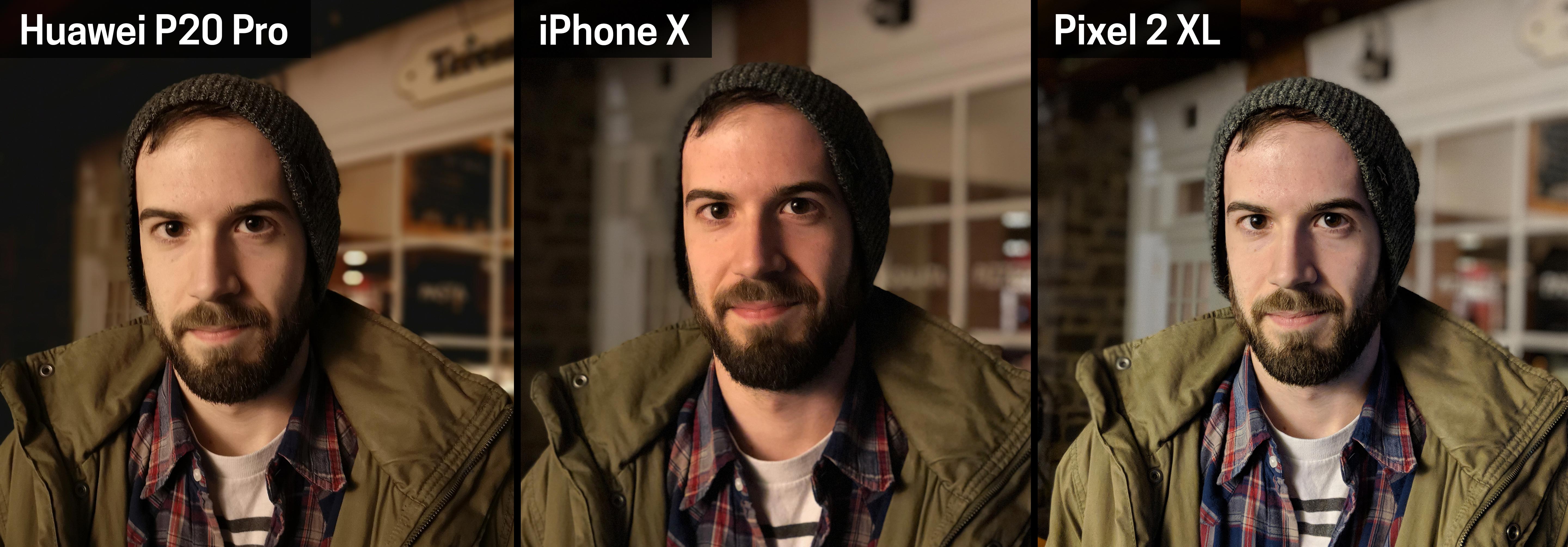Tested: The Huawei P20 Pro's Camera Beats the iPhone X, Pixel 2 XL
We put Huawei's triple-camera marvel up against the two best phones for photography out there: the Pixel 2 and iPhone X.
When it comes to photography, it's typically better to double down on quality over quantity. Countless handsets have proved that more megapixels — and, as of late, more lenses — don't necessarily produce images that are appreciably better. Just look at the Google Pixel 2, which needs only one camera to become our favorite camera phone.

And then came Huawei. You can't technically buy the China-based company's latest premium offering on our shores, but that hasn't stopped the world from gushing over the kinds of photos it can capture — especially at night.
The Huawei P20 Pro has three Leica-branded cameras. The main one is a 40-megapixel shooter with an f/1.8 aperture and an absolutely massive 1/1.7-inch image sensor. Above it is an 8-MP, f/2.4 telephoto lens that enables 3x optical zoom, while a 20-MP, f/1.6 monochrome unit on the bottom rounds out the trio.

All those lenses and pixels allow the P20 Pro to accomplish some pretty remarkable things. For starters, it can filter that wealth of data into an extremely precise, noise-free 10-MP image. With the help of a new feature called AI Stabilization, Huawei's phone can capture super-long exposures of 4 seconds at a time without the need for a tripod. And thanks to the onboard Neural Processing Unit, also featured in the Mate 10 Pro, the P20's main camera can identify subjects and scenes and automatically adjust parameters and modes to suit what it sees.
MORE: 2018's Most Anticipated Smartphones
But how does all that compare to what other leading camera phones can produce? To find out, we pitted the P20 Pro against its two fiercest competitors on the camera front — the Pixel 2 XL and the iPhone X — so you could witness the results for yourself.
| Rear Camera | Front Camera | Price | |
| Huawei P20 Pro | Triple: 40 MP (f/1.8); 20 MP monochrome (f/1.6); 8 MP telephoto (f/2.4) | 24 MP (f/2.0) | £799 / €899 |
| Apple iPhone X | Dual: 12 MP (f/1.8); 12 MP telephoto (f/2.4) | 7 MP (f/2.2) | $999 |
| Google Pixel 2 XL | Single: 12.2 MP (f/1.8) | 8 MP (f/2.4) | $849 |
We used all three cameras to shoot 10 photos, then turned to several members of the Tom's Guide team to pick their favorites. For each round, the winner received 3 points, second place got 2 points and third place earned 1 point. The results were pretty surprising.
Bryant Park
This photo of a sunny afternoon in New York provides a good baseline of each phone's shooting tendencies. The iPhone X routinely offered the brightest shots in sunlight, though its dynamic range wasn't always the best. The Pixel 2 frequently opted for more realistic, muted tones with excellent detail, though they could sometimes come off as drab.
Here, the P20 Pro strikes something of a balance between its two rivals. Huawei's camera features a technology the company calls Master AI, which automatically tweaks settings based on the scenario being captured. Although Master AI is very good at sussing out particular situations — it never failed to identify something once in my experience — it can be easily confused by competing portions of a frame. In this case, the P20 Pro vacillated between homing in on the green grass and the blue sky, with successive shots looking very different based on the filter applied.

Ultimately, I was able to capture an image with the sky filter applied. Based on our in-office survey, that did the trick. The P20 Pro's shot was favored here for its sharpness and vivid color. The Pixel 2 finished a close second, as it transformed this otherwise picturesque spring scene into a cloudier affair. It's important to note that while I didn't turn the Master AI off during all but one of these tests (as I wanted to experience the full brunt of the P20 Pro's automatic processing capabilities), you can easily do so from the settings menu. View full-size image
Round #1: Bryant Park
1st place: Huawei P20 Pro
2nd place: Pixel 2 XL
3rd place: iPhone X
Nassau Hall
Princeton University’s historic Nassau Hall served as the venue for this challenging late-night test, where the P20 Pro truly demonstrated its low-light prowess. When you understand how Huawei's camera is able to achieve the shot, it's easy to see why.
The P20 Pro comes equipped with a specialized Night Mode, which leaves the shutter open for 4 seconds but amazingly doesn't require the use of a tripod. The P20 Pro eliminates the smudging you'd normally get from shaky hands with a feature called AI Stabilization. The longer the exposure time, the more light reaches the sensor — and that translates to a brighter shot with significantly less noise than the iPhone X or Pixel 2 XL can deliver.

If there's one downside to Huawei's approach, though, it relates to movement. That 4- second-long exposure means objects in motion, like the tree branches toward the top of the frame, become eerily fuzzy. AI Stabilization attempts to make the best of the situation and stitch everything together, but the result can be patchy. What stays still looks brilliant, but what doesn’t will never be adequately captured. View full-size image
Round #2: Nassau Hall
1st place: Huawei P20 Pro
2nd place: Pixel 2 XL
3rd place: iPhone X
Portrait
Who says you need two lenses to nail portraits? The Pixel 2 XL snagged this battle, thanks to proper metering that compensated for the warm glow of overhead lights, and a crispness that was plainly lacking from Huawei and Apple's handsets.

Google's device also took home the bulk of the points for its excellent HDR+ mode, which kept the darker aspects of the scene — from the model's facial hair to the wrinkles in his coat — perfectly visible, without sacrificing the highlights. Surprisingly, both multilens phones in this comparison had a much more difficult time distinguishing the foreground from the background, which can be observed along the edge of the subject's winter cap. View full-size image
Round #3: Portrait
1st place: Pixel 2 XL
2nd place (tie): Huawei P20 Pro, iPhone X
Cherry blossoms
For these photos of a cherry blossom tree, each device's respective zoom function was used. For the iPhone X and P20 Pro, it was 2x and 3x optical zoom, respectively. For the Pixel 2 XL, which does not have a second lens, we used the digital zoom comparable to the other two handsets.
The P20 Pro's flower mode dialed up the saturation to 11, drawing a robust blend of pink and purple out of the cherry blossoms that the other phones didn't approach. However, that came at the expense of sharpness, as the P20 Pro's attempt is also considerably blurrier than that of the iPhone or even the digitally zooming Pixel. Compared with the other two, it definitely appears to be the most processed, and most of us weren't smitten with the result.

Those with a preference for more natural colors will favor the iPhone, which finished first by some distance, thanks to good overall detail (especially in the texture of the branches), as well as a pronounced but measured contrast. Google's flagship placed last with the darkest and noisiest effort of the trio. View full-size image
Round #4: Cherry blossoms
1st place: iPhone X
2nd place: Huawei P20 Pro
3rd place: Pixel 2 XL
Merry-Go-Round
After a stratospheric start, the P20 Pro came crashing back down to Earth in this next test, taken at a carousel in Bryant Park. The iPhone X demonstrated a painterly warmth that set it apart from the cold and clinical shot courtesy of the P20 Pro, and a slightly more balanced offering from the Pixel 2 XL.

Apple's HDR shines in this round. The shadow cutting across the center of the merry-go-round creates a tricky task for these phones, which do their best to balance light and dark. But the depths of the carousel are still plainly visible and well-lit in the iPhone's shot, while the P20 Pro and Pixel cut a much shallower gradation between the highlights and lowlights. View full-size image
Round #5: Merry-Go-Round
1st place: iPhone X
2nd place: Pixel 2 XL
3rd place: Huawei P20 Pro
Water mill
In shooting this photo of a water mill, I wanted to get a feel for what the P20 Pro's HDR mode could do alone, without the help of any AI-applied filters. Unfortunately, the results weren't encouraging. The whole frame is washed-out and overexposed, with a greenish-gray tint that evokes the earliest HDR applications in smartphones from five years ago.

Apple and Google fared much better in that regard, such that only one vote separated the pair. If you look closely, the Pixel 2 XL delivers more detail in the mill's wooden walls and stone siding, and deeper shadows that convey a sense of depth to the trees without being too overwhelming. View full-size image
Round #6: Water mill
1st place: Pixel 2 XL
2nd place: iPhone X
3rd place: Huawei P20 Pro
Food
Who's hungry for pierogies? Foodies will enjoy the P20 Pro's dedicated shooting mode that makes your favorite bar snack look positively Instagram-worthy. Huawei's software pumps up the brightness and saturation to make the dish pop in all the right places — especially compared with the iPhone's dingy and dim representation, which explains Apple's last-place finish in this round.

Still, some will likely find the P20 Pro is a bit too aggressive here. For those diners, the Pixel 2 XL offers a delicious alternative. Relative darkness aside, Google's phone captures the crispy texture of the dough better than any other, with the perfect palette of golden-brown hues to set your mouth watering. View full-size image
Round #7: Food
1st place: Huawei P20 Pro
2nd place: Pixel 2 XL
3rd place: iPhone X
Windowsill
Back in the office, neither the iPhone X nor the Pixel 2 XL could compete with the P20 Pro's penchant for picking up fine textures, like those of the plant's leaves and the white paint on the wall. Huawei's camera deftly preserved the spectrum of greens and the roughness of the pot the plant was seated in. You can see multitudes of detail in the P20 Pro'’s shot without even zooming in, that are omitted from the iPhone's exposure.

That said, there's still some room for improvement. The Pixel 2 demonstrated better overall white balance — something that particularly stands out when you look at the center of the timer, or the surface of the windowsill. View full-size image
Round #8: Windowsill
1st place: Huawei P20 Pro
2nd place: Pixel 2 XL
3rd place: iPhone X
Bar
A dimly lit bar provided another excellent opportunity to demonstrate the power of the P20 Pro's Night Mode. Pay close attention to the interior lighting and fridge — Google's handset almost reins in those highlights, while the iPhone X doesn't even come close. The P20 Pro claims yet another balanced low-light scene, with impeccable detail toward the center of the frame.

Granted, as you venture toward the edges, things get a bit fuzzy. Still, the P20 Pro is able to avoid some of the pitfalls that sink its two competitors in this round, such as the iPhone's monochromatic palette and the Pixel's tendency to bathe indoor scenes in harsh warm light. View full-size image
Round #9: Bar
1st place: Huawei P20 Pro
2nd place: Pixel 2 XL
3rd place: iPhone X
Daffodils
We come to one last flower comparison, where the P20 Pro's Master AI proved its worth a final time. There's a certain softness to the filter applied, but in this case, our panel felt the effect was appropriate. The P20 Pro also wasn't shy about going heavier on the background bokeh than its rivals, which lent portrait-style artistry to an otherwise ordinary still-life scene.

That's not to say either the iPhone X or Pixel 2 XL struggled here. We liked the intensity of the yellow in those petals captured by Apple's flagship, while the Pixel once again favored more realistic colors — something that's easiest to tell by the shade of gray of the buildings in the distance. On the iPhone and P20 Pro, they're borderline pink. View full-size image
Round #10: Daffodils
1st place: Huawei P20 Pro
2nd place: iPhone X
3rd place: Pixel 2 XL
Overall Winner: Huawei P20 Pro
We had a feeling the P20 Pro would excel in low light, but we didn't anticipate it upsetting the duopoly of smartphone cameras shared by Google and Apple. Imaging is perhaps the most rapidly innovating aspect of the mobile industry, and Huawei has just stolen the throne — for now, anyway.
| Round | Huawei P20 Pro | iPhone X | Pixel 2 XL |
| #1: Bryant Park | 3 | 1 | 2 |
| #2: Nassau Hall | 3 | 1 | 2 |
| #3: Portrait | 2 | 2 | 3 |
| #4: Cherry blossoms | 2 | 3 | 1 |
| #5: Merry-Go-Round | 1 | 3 | 2 |
| #6: Water mill | 1 | 2 | 3 |
| #7: Food | 3 | 1 | 2 |
| #8: Windowsill | 3 | 1 | 2 |
| #9: Bar | 3 | 1 | 2 |
| #10: Daffodils | 3 | 2 | 1 |
| Overall Score | 24 points | 17 points | 20 points |
Like any camera, the P20 Pro isn't perfect. The AI-powered processing can be heavy-handed at times, leading to oversaturated images purists will surely decry. And the camera interface itself on the P20 Pro is quite a bit more complicated than that of the Pixel 2 XL or the iPhone X, which both take a less-is-more approach to features.
MORE: Galaxy S9's Camera Takes on Pixel and iPhone
Yet those phones have no counterpart to the P20's Night Mode, which presents a major step forward for mobile photography the likes of which we haven't seen since the iPhone 7 Plus popularized shallow depth-of-field portraits. Huawei has already achieved something remarkable in this first iteration, and while we can't definitively call the P20 Pro the best smartphone camera for all scenarios, it's definitely the one we’d want in our pockets when the lights go down.
Credit: Tom's Guide
Sign up to get the BEST of Tom's Guide direct to your inbox.
Get instant access to breaking news, the hottest reviews, great deals and helpful tips.
Adam Ismail is a staff writer at Jalopnik and previously worked on Tom's Guide covering smartphones, car tech and gaming. His love for all things mobile began with the original Motorola Droid; since then he’s owned a variety of Android and iOS-powered handsets, refusing to stay loyal to one platform. His work has also appeared on Digital Trends and GTPlanet. When he’s not fiddling with the latest devices, he’s at an indie pop show, recording a podcast or playing Sega Dreamcast.
-
busabashi Yes, ESPECIALLY in low light the LEICA cam in the Huawei P20 Pro highlights how far behind the iPhone's cameras are--like 2 YEARS!Reply -
paul.mcgowan75 Crap review, the P20 is inferior in many shots, lack of detail and you need a 4 second exposure for low light shots too - hahahaha wowReply
